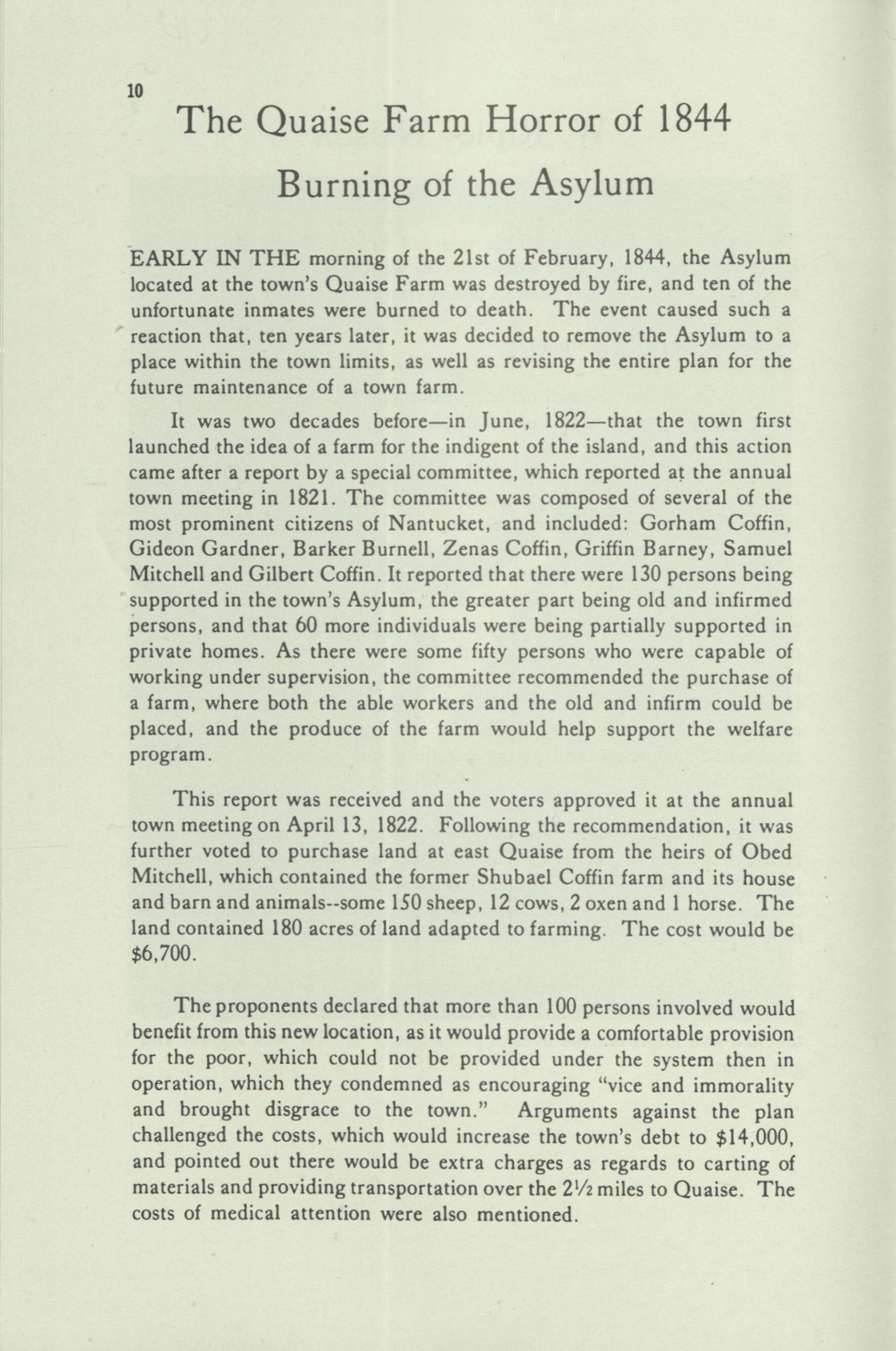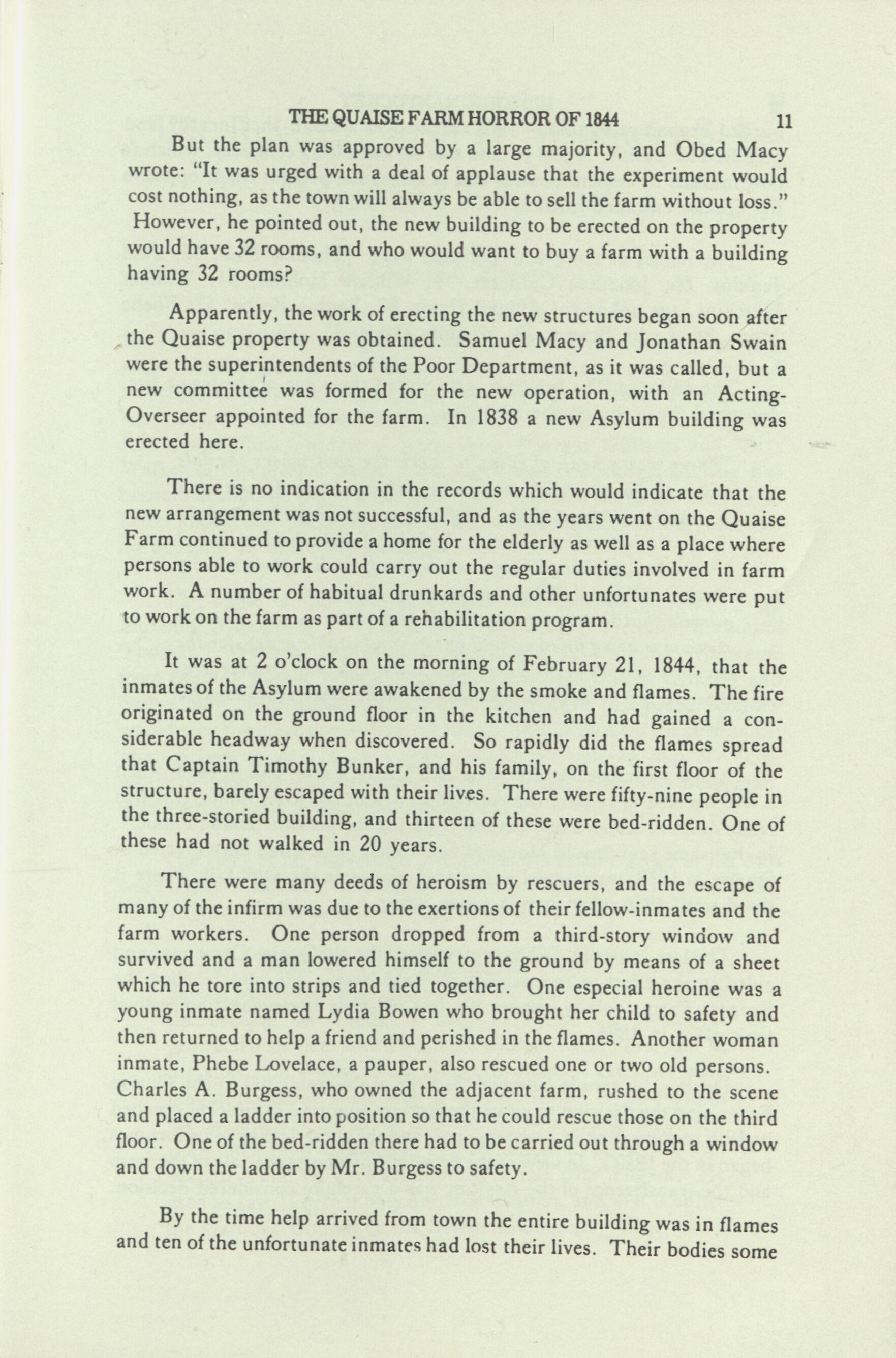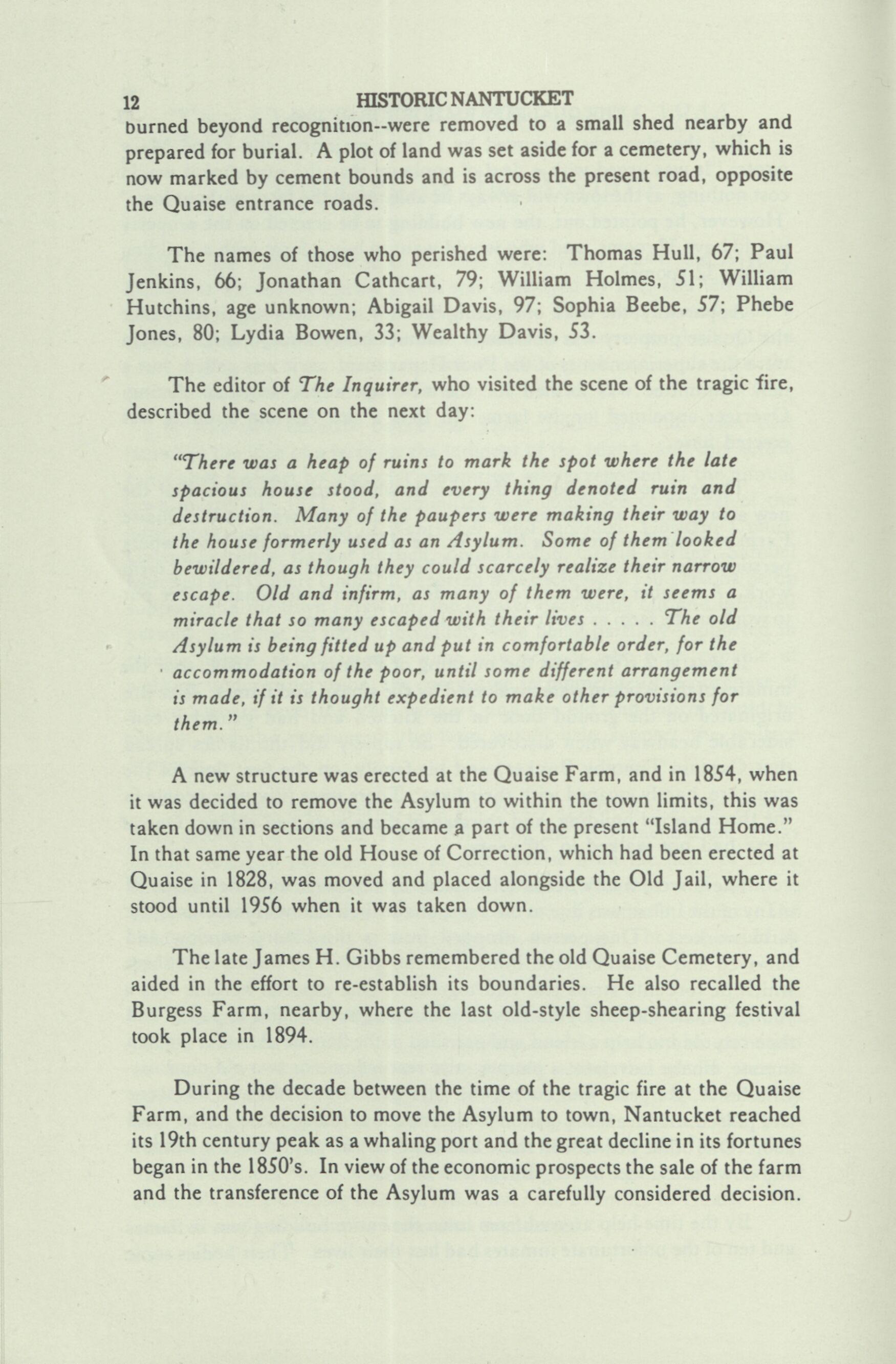
6 minute read
The Quaise Farm Horror of 1844
T h e Q u a i se F a rm H o r ro r o f 1 8 4 4
B u rn in g o f t h e A s y lu m
EARLY IN THE morning of the 21st of February, 1844, the Asylum located at the town's Quaise Farm was destroyed by fire, and ten of the unfortunate inmates were burned to death. The event caused such a reaction that, ten years later, it was decided to remove the Asylum to a place within the town limits, as well as revising the entire plan for the future maintenance of a town farm.
It was two decades before—in June, 1822—that the town first launched the idea of a farm for the indigent of the island, and this action came after a report by a special committee, which reported at the annual town meeting in 1821. The committee was composed of several of the most prominent citizens of Nantucket, and included: Gorham Coffin, Gideon Gardner, Barker Burnell, Zenas Coffin, Griffin Barney, Samuel Mitchell and Gilbert Coffin. It reported that there were 130 persons being supported in the town's Asylum, the greater part being old and infirmed persons, and that 60 more individuals were being partially supported in private homes. As there were some fifty persons who were capable of working under supervision, the committee recommended the purchase of a farm, where both the able workers and the old and infirm could be placed, and the produce of the farm would help support the welfare program.
This report was received and the voters approved it at the annual town meeting on April 13, 1822. Following the recommendation, it was further voted to purchase land at east Quaise from the heirs of Obed Mitchell, which contained the former Shubael Coffin farm and its house and barn and animals—some 150 sheep, 12 cows, 2 oxen and 1 horse. The land contained 180 acres of land adapted to farming. The cost would be $6,700.
The proponents declared that more than 100 persons involved would benefit from this new location, as it would provide a comfortable provision for the poor, which could not be provided under the system then in operation, which they condemned as encouraging "vice and immorality and brought disgrace to the town." Arguments against the plan challenged the costs, which would increase the town's debt to $14,000, and pointed out there would be extra charges as regards to carting of materials and providing transportation over the 2Vi miles to Quaise. The costs of medical attention were also mentioned.
THE QUAISE FARM HORROR OF 1844 11
But the plan was approved by a large majority, and Obed Macy wrote: "It was urged with a deal of applause that the experiment would cost nothing, as the town will always be able to sell the farm without loss." However, he pointed out, the new building to be erected on the property would have 32 rooms, and who would want to buy a farm with a building having 32 rooms?
Apparently, the work of erecting the new structures began soon after the Quaise property was obtained. Samuel Macy and Jonathan Swain were the superintendents of the Poor Department, as it was called, but a new committee was formed for the new operation, with an ActingOverseer appointed for the farm. In 1838 a new Asylum building was erected here.
There is no indication in the records which would indicate that the new arrangement was not successful, and as the years went on the Quaise Farm continued to provide a home for the elderly as well as a place where persons able to work could carry out the regular duties involved in farm work. A number of habitual drunkards and other unfortunates were put to work on the farm as part of a rehabilitation program.
It was at 2 o'clock on the morning of February 21, 1844, that the inmates of the Asylum were awakened by the smoke and flames. The fire originated on the ground floor in the kitchen and had gained a considerable headway when discovered. So rapidly did the flames spread that Captain Timothy Bunker, and his family, on the first floor of the structure, barely escaped with their lives. There were fifty-nine people in the three-storied building, and thirteen of these were bed-ridden. One of these had not walked in 20 years.

There were many deeds of heroism by rescuers, and the escape of many of the infirm was due to the exertions of their fellow-inmates and the farm workers. One person dropped from a third-story window and survived and a man lowered himself to the ground by means of a sheet which he tore into strips and tied together. One especial heroine was a young inmate named Lydia Bowen who brought her child to safety and then returned to help a friend and perished in the flames. Another woman inmate, Phebe Lovelace, a pauper, also rescued one or two old persons. Charles A. Burgess, who owned the adjacent farm, rushed to the scene and placed a ladder into position so that he could rescue those on the third floor. One of the bed-ridden there had to be carried out through a window and down the ladder by Mr. Burgess to safety.
By the time help arrived from town the entire building was in flames and ten of the unfortunate inmates had lost their lives. Their bodies some
12 HISTORIC NANTUCKET
burned beyond recognition—were removed to a small shed nearby and prepared for burial. A plot of land was set aside for a cemetery, which is now marked by cement bounds and is across the present road, opposite the Quaise entrance roads.
The names of those who perished were: Thomas Hull, 67; Paul Jenkins, 66; Jonathan Cathcart, 79; William Holmes, 51; William Hutchins, age unknown; Abigail Davis, 97; Sophia Beebe, 57; Phebe Jones, 80; Lydia Bowen, 33; Wealthy Davis, 53.
The editor of The Inquirer, who visited the scene of the tragic fire, described the scene on the next day:
"There was a heap of ruins to mark the spot where the late spacious house stood, and every thing denoted ruin and destruction. Many of the paupers were making their way to the house formerly used as an Asylum. Some of them looked bewildered, as though they could scarcely realize their narrow escape. Old and infirm, as many of them were, it seems a miracle that so many escaped with their lives The old
Asylum is being fitted up and put in comfortable order, for the ' accommodation of the poor, until some different arrangement is made, if it is thought expedient to make other provisions for them."

A new structure was erected at the Quaise Farm, and in 1854, when it was decided to remove the Asylum to within the town limits, this was taken down in sections and became a part of the present "Island Home." In that same year the old House of Correction, which had been erected at Quaise in 1828, was moved and placed alongside the Old Jail, where it stood until 1956 when it was taken down.
The late James H. Gibbs remembered the old Quaise Cemetery, and aided in the effort to re-establish its boundaries. He also recalled the Burgess Farm, nearby, where the last old-style sheep-shearing festival took place in 1894.
During the decade between the time of the tragic fire at the Quaise Farm, and the decision to move the Asylum to town, Nantucket reached its 19th century peak as a whaling port and the great decline in its fortunes began in the 1850's. In view of the economic prospects the sale of the farm and the transference of the Asylum was a carefully considered decision.










